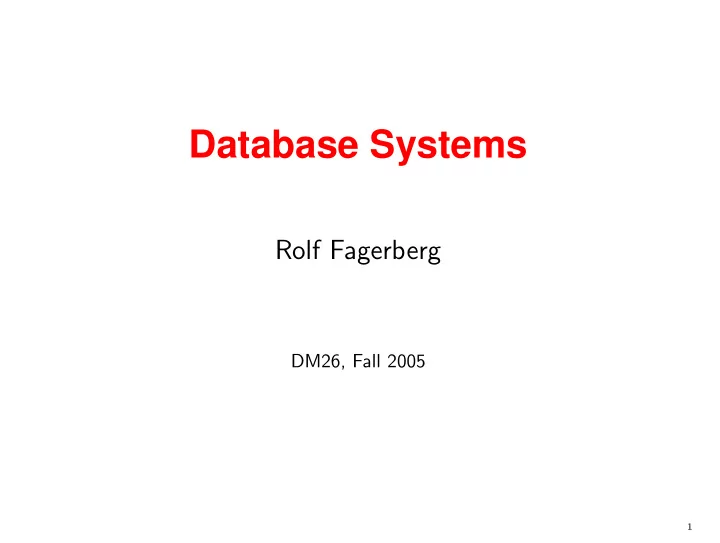

Database Systems Rolf Fagerberg DM26, Fall 2005 1
Course Literature Database Management Systems , Ramakrishnan and Gehrke. Exam Oral exam, 13-scale Project Database design and implementation project (DB: PostgreSQL). Hours Two lectures a week Two exercise lessons a week (for each of two classes). 2
Need for Databases • Corporate data (payrolls, inventory, sales, customers, accounting, documents,. . . ) • Banking systems • Stock exchanges • Airline systems • University data (students, grades) • Hospitals • Scientific data • Website backends • Personal data (CD collection, addresses,. . . ) 3
Database Desiderata • Ease of use • Flexible searching • Efficiency • Centralized storage, multi-user access • Scalability (large amounts of data) • Security and consistency: – Concurrency issues – System crashes – Access control – Integrity constraints on data • Abstraction (implementation hiding) • Good data modeling 4
Current Systems • DBMS = Database Management System • Many vendors (Oracle, IBM DB2, MS SQL Server, MySQL, PostgreSQL,. . . ). • All rather similar. • Very big systems. Surprisingly easy to use. Common features: • Relational model • SQL as query language • Server-client architecture 5
History Early 60’s Integrated Data Store , General Electric. First general purpuse DBMS. Network data model. Late 60’s Information Management System , IBM (still in use!) Hierarchical data model. 1970 E. Codd: Relational data model, relational query languages. 6
History (Cont.) Mid 70s First relational DBMSs (IBM System R, UC Berkeley Ingres,. . . ). 80s Almost all commercial systems now based on relational model. SQL standardized. 90s Additional features added to DBMS: richer data types (large objects, OO-features), tools for manament, report generation, business analysis, data mining. Object-oriented DBMS appear, but not dominant. 7
Why Study DBs? • Very widely used. • Part of many software solutions. • DB expertise is a career asset. • Interesting: – Mix of many different requirements – Mix of many different methodologies – Real world application On the downside: Real world applicability has top priority. Heuristics more than theory, few theorems. 8
DB People • End users (zillions) • Application programmers (billions) • DBMS administrators (millions) • DBMS suppliers (thousands) 9
DB development • Requirement specification (not covered here) • Data modeling (conceptual design) • Database modeling (database design) • Application programming (interface for end users) • Database tuning 10
Issues covered in course Using DBs: • E/R-model for data modeling • Relational model (data model, relational query languages, normal forms) • SQL syntax • Application programming • DB tuning 11
Issues covered in course (Cont.) DBMS implementation principles: • Physical data storage • Index structures • Query parsing, optimization, execution • Concurrency control (transactions) • Crash recovery Important background knowledge for efficient use of DBs, in particular for tuning. 12
Note • Database Systems Course � = SQL • Database Systems Course � = Oracle, IBM, PostgreSQL,. . . Database Systems Course = principles of use and implementation of (relational) database systems. 13
Recommend
More recommend